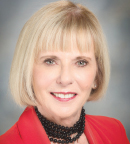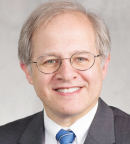
Elizabeth L. Travis, PhD, FASTRO

Ethan Dmitrovsky, MD
IT IS A SAD TRUTH that academic medicine, like many other professions, has a glass ceiling that hampers its ambitions. In medicine, this glass ceiling blocks women and minority faculty from reaching the highest ranks of leadership. Even if the root cause is not yet known, we want to eliminate this disparity at our institution.
Our motive is not just about social responsibility. It is about what is in the best interests of our institution and our patients as well as academic medicine as a whole. Our workforce, like every cancer center’s workforce, should reflect the diversity of the patients it treats.
Although medical and graduate schools have long admitted comparable numbers of men and women, far fewer women have risen to leadership positions. According to a 2015 Association of American Medical Colleges report,1 only 15% of department chairs, 16% of medical school deans, and 11% of cancer center directors are women.2
To remedy this disparity in our institution, in 2007, The University of Texas MD Anderson Cancer Center created the Office of Women Faculty Programs with the goal of increasing recruitment, retention, and advancement of a diverse faculty. When the program was launched, only 33% of our faculty and just 14% of our department chairs were women. Today, 39% of our faculty and 29% of our department chairs are women. This progress happened because we saw the need to reduce our gender gap.
Reducing Pay Inequity in Oncology Care
FOLLOWING THE ESTABLISHMENT of the Office of Women Faculty Programs, we put multiple initiatives into place. To begin, we recruited and appointed a respected female faculty member, and coauthor of this commentary, Elizabeth L. Travis, PhD, FASTRO, to our senior leadership team as Associate Vice President. Next, we assembled an office staff and devoted institutional funds to support both the staff and the costs of coaching services and leadership training for women faculty. Dr. Travis led our annual faculty salary analysis, paying attention to potential gender gaps in salary. As a consequence, salary inequities are rare and addressed quickly when found.
This institutional focus on reducing the gender gap led us to consider the broader topic of disparity in our minority faculty. Although minorities, both men and women, were present on our faculty, they were in disappointingly low numbers. Although their proportion mirrored national trends,3 their low representation at our center was still unacceptable. We wanted our faculty’s diversity to reflect that of our home city. Houston has no majority demographic group, and soon this will be the case in our nation.
“Only 15% of department chairs, 16% of medical school deans, and 11% of cancer center directors are women.”— Elizabeth L. Travis, PhD, FASTRO, and Ethan Dmitrovsky, MD
Tweet this quote
To confront the issue of faculty disparity, we turned to our Office of Women Faculty Programs to fashion a solution. We reasoned that an increase in the office’s scope would enhance faculty diversity and promote advancements for both men and women. To reflect a broader purpose of its mission, in 2016, the Office of Women Faculty Programs became the Office of Women and Minority Faculty Inclusion. The reconstituted and larger program’s mission is to recruit, retain, and advance the careers of both women and minority faculty. Time will tell whether this model is worth replicating elsewhere.
Cultivating Future Leaders in Oncology
LEVERAGING WHAT we have already learned from these early efforts, we crafted a new opportunity for women and minority faculty. This past year, we launched a sponsorship program with the goal of identifying promising future leaders in oncology. Nominated by their division heads and faculty senate leadership, participants will shadow the Chief Academic Officer to gain first-hand experience of what it is like to work at this level of academic leadership. All faculty members are eligible to participate in this program, but we are focusing our attention on finding candidates from the ranks of our women and minority faculty.
Our first class is now in place. Once its members have completed the program, we hope some of them will set their sights on pursuing the highest levels of academic leadership. At the very least, this program will help us sponsor the next generation of diverse academic leaders.
Although our program is specific to the needs and opportunities at MD Anderson, our commitment is to assist others in diversifying their leadership. With that in mind, we are open to sharing our experiences with other institutions interested in reducing disparities within their own walls. We have extended facets of our sponsorship program with all institutions in The University of Texas System as well as our partners at the University of Puerto Rico.
“We wanted our faculty’s diversity to reflect that of our home city. Houston has no majority demographic group, and soon this will be the case in our nation.”— Elizabeth L. Travis, PhD, FASTRO, and Ethan Dmitrovsky, MD
Tweet this quote
When working to diversify institutional leadership, we urge our colleagues to consider both formal and informal approaches. Sponsorship may be as simple as current leaders working to raise the visibility of future leaders or may follow a more comprehensive approach such as ours. In any case, it requires dedicated effort and support from all levels of leadership, all with the goal of ensuring no one is overlooked within the next generation of potential leaders.
Need for Diverse Workforce
THIS ENDEAVOR has a serious endgame. Cancer specialists confront frightening maladies, and there is no shortage of public health challenges for them to solve. But to provide the most effective oncology care for an increasingly diverse population requires deployment of the full potential of a similarly diverse community of oncologists.
None of us knows where solutions to puzzling medical problems will come from, but each of us has a stake in having a diverse workforce to guarantee that every oncologist and cancer scientist has an equal opportunity to find those solutions. Otherwise, all of us will collide with an unseen obstacle to making those discoveries: the glass ceiling. ■
DISCLOSURE: Drs. Travis and Dmitrovsky reported no conflicts of interest.
REFERENCES
1. Association of American Medical Colleges: The State of Women in Academic Medicine: The Pipeline and Pathways to Leadership. Washington, DC: AAMC; 2013–2014.
2. Cancer Center List: Office of Cancer Centers, National Cancer Institute (NCI) at the National Institutes of Health (NIH); 2013. Available at http://cancercenters. cancer.gov/cancer_centers/cancer-centers-names4.html. Accessed July 27, 2017.
3. Magrane D, Lang J, Alexander H, et al: Women in U.S. Academic Medicine: Statistics and Benchmarking Report 2008-2009. Association of American Medical Colleges; 2009. Available at https://www.aamc.org/download/182738/ data/gwims_stats_2008-2009.pdf. Accessed October 9, 2017.

